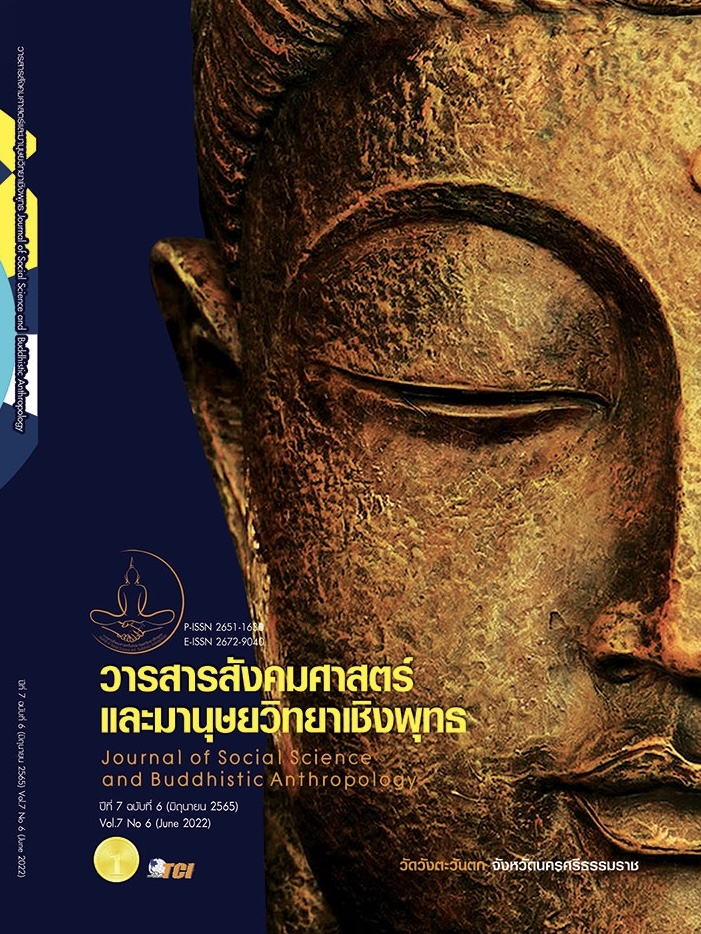SITUATIONS PROBLEMS, NEEDS, AND GUIDELINES IN PHYSICAL EDUCATION LEARNING MANAGEMENT MODEL ON RHYTHMIC ACTIVITIES APPLYING PHENOMENON-BASED LEARNING APPROACH
Keywords:
Physical Education Learning Management, Rhythmic Activities, Phenomenon-Based - Learning Management, 21st-Century SkillsAbstract
This qualitative research aims to investigate problems, needs, and guidelines in the physical education learning management model on rhythmic activities applying a phenomenon-based learning approach for secondary education. The data were collected from 1) the interview of 8 teachers who have taught physical education, social studies, arts, and English subjects and a group discussion of 20 students enrolled in the rhythmic activities course from two secondary schools. This study further explores the problems and needs of physical education instruction in case of rhythmic activities integrated with social studies, arts, and English subjects using analytic induction and comparative analysis; 2) the interview of 5 experts using content analysis. The findings show that 1) the problems encompass the lack of objectives identifying the real-world applications and the 21st-century skills development, the lack of integration in terms of content and learning activities with other subjects, the shortage of learning materials for reviewing the steps, the inability to explain the content of rhythmic activities, the differences of the skills amongst the dancing partners, and the irresponsibility of task submission. 2) Needs include the identification of clear, measurable learning objectives pertinent to the 21st-century skills, the integration with other learning areas, the increase of practice time, explaining the understanding of societal contexts, gender, and learning differences, the accessibility of video clips for further study, and the collaborative assessment of the teachers and students focusing mainly on dancing skills and the 21st-century skills. 3) Guidelines for the learning management should focus on the conceptualization of the key competencies, the implementation of the learning activities integrated with contents on physical education, social studies, arts, and English subjects, the emphasis on the knowledge applicability, the usage of easily accessible learning materials, and on the collaborative assessment between learners and teachers.
References
ชลาธิป สมาหิโต. (2562). การจัดประสบการณ์การเรียนรู้โดยใช้ใช้ปรากฏการณ์เป็นฐาน. วารสารมหาวิทยาลัย ศิลปากร, 39(1): 113-129.
ถนอมขวัญ ทองโปร่ง , กาญจนา สิ่งประสงค์ , คณิศร ธีระวิทย์ และพัชรินันท์ ยังทรัพย์อนันต์ และภิฑชญา สุนทรกลัมพ์. (2563). การศึกษาสภาพปัญหาการใช้นวัตกรรมการจัดการเรียนการสอนของอาจารย์โรงเรียนสาธิตมหาวิทยาลัยรามคำแหง ฝ่ายมัธยม, วารสารศิลปการจัดการ, 4(1), 124-139.
ผกาวดี สะเภาคำ. (2558). สภาพการจัดการเรียนการสอนพลศึกษาในโรงเรียนมัธยมศึกษาภาคเหนือของประเทศ ไทย. สักทอง วารสารมนุษยศาสตรและสังคมศาสตร, 21(1): 145-159.
ราชกิจจานุเบกษา. (2561). ยุทธศาสตร์ชาติ 20 ปี (พ.ศ. 2561 - 2580). เรียกใช้เมื่อ 3 กันยายน 2564 จาก http://www.ratchakitcha.soc.go.th/DATA/PDF/2561/A/082/T_0001.PDF.
ฤทธิไกร ไชยงาม, กันยารัตน์ ไวคำ, หทัย ไชยงาม. (2561). ปัญหาและแนวทางการแก้ไขเพื่อพัฒนาทักษะผู้เรียน ภาษาอังกฤษของชุมชนเรียนรู้ทางวิชาชีพครูผู้สอนภาษาอังกฤษในสังกัดองค์การบริหารส่วนจังหวัด ขอนแก่น. วารสารศึกษาศาสตร์ มหาวิทยาลัยมหาสารคาม, 12(2), 7-17.
วิจารณ์ พานิช. (2555). วิถีสร้างการเรียนรู้เพื่อศิษย์ในศตวรรษที่ 21. กรุงเทพฯ: มูลนิธิสดศรีสฤษดิ์วงศ์.
สถาบันส่งเสริมการสอนวิทยาศาสตร์และเทคโนโลยี กระทรวงศึกษาธิการ. (2559). สรุปผลการวิจัย PISA 2015. เรียกใช้เมื่อ 3 กันยายน 2564 จาก http://www.oic.go.th/FILEWEB/CABINFOCENTER6/DRAWER056/GENERAL/DATA0000/00000070.PDF.
สำนักงานกองทุนสนับสนุนการสร้างเสริมสุขภาพ. (2554). กิจกรรมเคลื่อนไหวเสริมทักษะพัฒนาการเด็ก. เรียกใช้เมื่อ 1 กันยายน 2564 จาก http://talkaboutsex.thaihealth.or.th/knowledge/934.
สำหรับเด็กปฐมวัย. วารสารมหาวิทยาลัยศิลปากร, 30(1): 113-129.
อดุลย์ วังศรีคูณ. (2557). การศึกษาไทยในศตวรรษที่ 21 ผลผลิตและแนวทางการพัฒนา. วารสารมนุษยศาสตร์ และสังคมศาสตร์ บัณฑิตวิทยาลัย มหาวิทยาลัยราชภัฏพิบูลสงคราม. 8(1): 1-17.
อมรรัตน์ เหล็กกล้า. (2555). สภาพปัญหาและความต้องการพัฒนาเทคโนโลยีและนวัตกรรมทาง การศึกษาของ โรงเรียนอาชีวศึกษาเอกชน. ในวิทยานิพนธ์ศึกษาศาสตรมหาบัณฑิต สาขาพัฒนามนุษย์และสังคม. มหาวิทยาลัยสงขลานครินทร์.
อรพรรณ บุตรกตัญญู. (2561). การเรียนรู้โดยใช้ปรากฏการณ์เป็นฐานเพื่อสร้างมุมมองแบบองค์รวมและการเข้าถึงโลกแห่งความจริงของผู้เรียน. วารสารครุศาสตร์ จุฬาลงกรณ์มหาวิทยาลัย, 46(2): 348-365.
อัจศรา ประเสริฐสิน, เทพสุดา จิวตระกูล และ จอย ทองกล่อมศรี. (2560). การศึกษาแนวทางการจัดการ นวัตกรรมทางการศึกษาไปใช้ในการพัฒนาการเรียนการสอนและการทำวิจัย. วารสารบรรณศาสตร์ มศว, 10(2), 78-89.
Coopersmith. S. (1984). SEI: Self-esteem Inventories. California: Psychologist Press Inc.
EduCluster Finland. (2017). Phenomenon - Based Learning – Developing Teacher Competences. Finland.
Karlsson, P. (2016). Finding Leverage in Supporting Upper Comprehensive School Teachers with Phenomenon-Based Learning and Co-Design. (Master's of Creative Sustainability). Department of Design Aalto University.
Symeonidis, V., and Schwarz, J. F. (2020). Phenomenon-Based Teaching and Learning through the Pedagogical Lenses of Phenomenology: The Recent Curriculum Reform in Finland.
World Economic Forum. (2018). The Global Competitiveness Report 2017–2018. Retrieved September 4, 2021, from www.weforum.org/docs/GCR20172018/05FullReport/TheGlobalCompetitivenessReport %E2%80%932018.pdf.
Downloads
Published
Versions
- 2022-07-20 (2)
- 2022-06-30 (1)
How to Cite
Issue
Section
License
Copyright (c) 2022 Journal of Social Science and Buddhistic Anthropology

This work is licensed under a Creative Commons Attribution-NonCommercial-NoDerivatives 4.0 International License.







